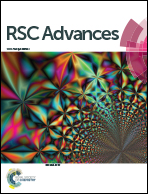Carbon nanotube impregnated anthracite (An/CNT) as a superior sorbent for azo dye removal
Abstract
Raw anthracite was impregnated with a minute amount of multi-walled carbon-nanotubes at a solid/solid ratio of 50 : 1 via calcination at 950 °C for 2 h to produce anthracite/carbon nanotube (An/CNT) composite with superior sorption efficiency. Both An/CNT composite and its precursor anthracite were characterized by XRD, SEM, FT-IR and BET surface area (SBET). The removal efficiency of an azo dye methyl orange (MO) by the An/CNT composite was evaluated under different experimental parameters. The MO sorption isotherm data fitted to the Langmuir model well with an R2 of 0.999 and a MO sorption capacity (qmax) of 416.7 mg g−1. The distribution coefficient Kd decreases from 117.9 to 16.1 L g−1 as the initial MO concentrations increased from 40 to 140 mg L−1. The MO sorption kinetic data was well described by the pseudo-second-order equation with an R2 of 1. The external (film) diffusion followed by intra-particle diffusion was the major driving process during the early stage of MO sorption. The electrostatic interaction between the oxygen- and nitrogen-bearing functional groups on the An/CNT surface and MO ions was the key controlling mechanism for the MO sorption process, particularly at pH < pHPZC of the composite. Meanwhile, valuable contributions from Yoshida and dipole–dipole H bonding mechanisms can explain the MO sorption by the addressed composite, especially at pH > pHPZC.



 Please wait while we load your content...
Please wait while we load your content...